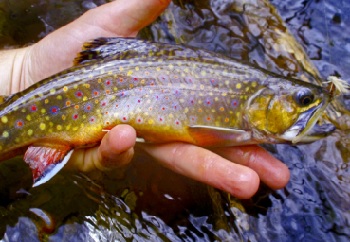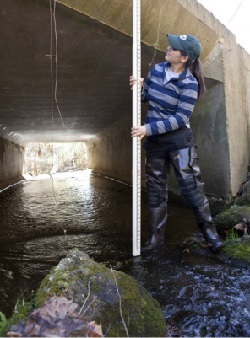PEC, Trout Unlimited and U.S. Fish & Wildlife Service join forces to help the eastern brook trout

Virginia’s state fish, the eastern brook trout, is in trouble. The Commonwealth’s only native trout has seen a sharp decline in population due to a detrimental combination of rising temperatures, physical barriers to streamflow, pollution, and habitat loss. Many expect the species to be added to VA’s Wildlife Action Plan list in the near future.
According to PEC’s Wildlife Habitat Program Manager, James Barnes, trout are marquee species for water quality. “Brook trout are like a canary in the coal mine,” he explains. “If they’re doing poorly, other species that we’re also interested in are probably doing poorly as well.”
For this reason, PEC has partnered with Trout Unlimited—an international organization focused on cold-water fish conservation. The organizations sent a joint mailing to every landowner in PEC’s region who lived on or near a trout stream to see what conservation issues interested them. An issue that a number of landowners showed interest in was stream crossings. Many people have crossings over streams that can be problematic for brookies. Whether it’s bridges, culverts or make-shift cement slabs, poorly-designed crossings can prevent trout from moving upstream to cooler waters as temperatures rise—a move they have to be able to make in order to survive hot summers.

with PEC’s James Barnes and Celia
Vuocolo — taking a variety of
measurements to help assess how
easily trout can move through various
crossings in the river basin.
Well-designed stream crossings allow for better water flow, benefiting fish and humans alike. Fish can travel up stream more easily, and there is less flooding and property damage after severe weather—meaning lower costs to landowners and the state. Getting to work: Stream crossings inventory
Analyzing and mitigating stream barriers in our region could do wonders for brookies, and—after securing grant funding from U.S. Fish and Wildlife Service—PEC and Trout Unlimited have started this process in the Rappahannock River Basin. The first step is to collect a thorough inventory of stream crossings in the watershed—a big job that Celia Vuocolo, PEC’s Habitat Program Assistant, has taken on with intern Ashleigh White.
“We’re taking a variety of measurements to help us assess how easily trout can move through these crossings,” Celia explains. “We’ve been seeing a lot of culverts that are perched above the waterline or have collapsed over time—both major impediments to trout passage.” Celia and Ashleigh plan to measure more than 110 crossings in the river basin.
“This is a first phase of what we hope is a long-term project,” says James. “After completing this inventory, we can develop a prioritized list of crossings that are most problematic for trout. Ideally, we can then roll into the next phase—working with landowners to create crossings that are not only better for fish, but also more durable and a better investment for the landowner… We’re focusing on stream crossings, but more broadly this is about rehabilitating and protecting our region’s water quality—from the headwaters to the Chesapeake Bay.” If you would like to learn more about this project, contact us at conservation@pecva.org.
This article was featured in our Winter 2013 Member Newsletter, The Piedmont View.
